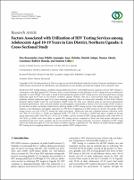| dc.contributor.author | Benyumiza, Deo | |
| dc.contributor.author | Amongin, Joan Fidelia | |
| dc.contributor.author | Ochaba, Isaac | |
| dc.contributor.author | Adupa, Morish | |
| dc.contributor.author | Abuch, Naume | |
| dc.contributor.author | Banula, Constance Babirye | |
| dc.contributor.author | Udho, Samson | |
| dc.date.accessioned | 2021-12-01T10:14:36Z | |
| dc.date.available | 2021-12-01T10:14:36Z | |
| dc.date.issued | 2021 | |
| dc.identifier.citation | Benyumiza, D., Amongin, J. F., Ochaba, I., Adupa, M., Abuch, N., Banula, C. B., & Udho, S. (2021). Factors Associated with Utilization of HIV Testing Services among Adolescents Aged 10-19 Years in Lira District, Northern Uganda: A Cross-Sectional Study. BioMed Research International, 2021. | en_US |
| dc.identifier.uri | https://doi.org/10.1155/2021/9568148 | |
| dc.identifier.uri | https://hdl.handle.net/123456789/361 | |
| dc.description.abstract | Background. HIV testing remains a problem among adolescents in low- and middle-income countries, and yet, HIV testing is a
cornerstone in the fight against HIV. However, there is scanty literature on the utilization of HIV testing services by adolescents
especially in rural settings. This study is aimed at determining the uptake of HIV testing services and associated factors among
adolescents aged 10-19 years in Lira District, Northern Uganda. Methods. This was a cross-sectional study done among 277
randomly selected adolescents aged 10-19 years attending outpatient clinics in Pentecostal Assembly of God (PAG) Mission
Hospital, Ngetta Health Center III, and Boroboro Health Center III. Data were collected using an interviewer-administered
structured questionnaire. Data collected included sociodemographic characteristics, history of test and receipt of HIV results in
the last three months, and facility-related factors affecting uptake of HIV testing services. Data analysis consisted of descriptive
statistics, cross-tabulations, and logistic regression at a 95% level of significance in SPSS version 25. Results. The uptake of HIV
testing services was 43% (119/277) among the study participants. Adolescents who had completed primary education (aOR:
5.47; 95% CI: 1.07-28.15; p = 0:042), are employed (aOR: 2.77; 95% CI: 1.16-6.60; p = 0:022), had used a condom in the last
sexual intercourse (aOR: 4.46; 95% CI: 1.78-11.15; p = 0:001), and are involved in HIV testing outreaches (cOR: 10.86; 95% CI:
3.81-30.93; p ≤ 0:001) were more likely to uptake HIV testing services compared to those who had tertiary education, are
unemployed, had never used a condom, and are not involved in HIV testing outreaches. Conclusion. Utilization of HIV testing
services by adolescents aged 10-19 in Lira District, Northern Uganda, is generally low. The Ministry of Health should strengthen
HIV testing services targeting adolescents to increase uptake of HIV testing services. | en_US |
| dc.language.iso | en | en_US |
| dc.publisher | BioMed Research International | en_US |
| dc.subject | HIV Testing Services | en_US |
| dc.subject | Northern Uganda | en_US |
| dc.title | Factors Associated with Utilization of HIV Testing Services among Adolescents Aged 10-19 Years in Lira District, Northern Uganda: A Cross-Sectional Study | en_US |
| dc.type | Article | en_US |

